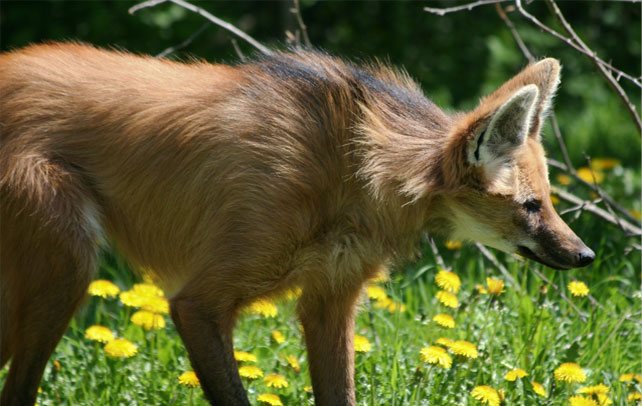Interesting Facts About Maned Wolf

Maned wolf belongs to canidae family which includes dogs, wolves, and foxes. But they are not true wolves. They look like an overgrown fox with very long legs and orange-reddish furs. Although they possess fox-like features but they are nowhere related to fox, wolf, coyote, dog, or jackal. Maned wolves have no contact with humans, apart from stealing their poultry animals and being attacked and killed by their pet dogs. They don’t form any packs and like to remain solitary, except during mating time. The mating period for maned wolves is from November to April and gestation period can vary from 62 to 66 days. The pups grow to full size in one year’s time. Maned wolf is a nocturnal animal and hunts during dawn and dusk. They hunt and kill their prey by biting on its neck and sometimes shaking them severely. Check out some more amazing facts on maned wolf.
Fast Facts
Scientific Name: Chrysocyon brachyurus
Kingdom: Animalia
Phylum: Chordata
Subphylum: Vertebrata
Class: Mammalia
Order: Carnivora
Family: Canidae
Subfamily: Caninae
Genus: Chrysocyon
Origin: Pleistocene
Species: C.brachyurus
Diet: Fruits, guinea pigs, rabbits, rodents, lizards, frogs, birds, fish, and snails.
Size: 67 to 107cm
Weight: 20 to 35kg
Life Span: 12 to15 years
Natural Habitat: Dry, shrubby forests, and grasslands
Call: Roar-bark, growls and high-pitched whine
Gestation Period: 62 to 66 days
Number of Offspring: 2 to 6
Interesting And Fun Facts About Maned Wolf
- The maned wolf is known by several names in different regions. Aguará guazú, lobo de los esteros or lobo Colorado, borochi, lobo-guará, and lobo de crin are its common names.
- As it is very long with fox-like features, therefore it has won the appellation of ‘fox on stilts’.
- The maned wolf is also known as skunk wolf because of its distinctive odour.
- These wolves survive in central and southeasternBrazil,Paraguay, easternBolivia, and northernArgentina.
- They are a combination of wolf, hyena, fox, and hunting dogs. Some of the common features that the manned wolf has borrowed from these animals are body structure, coat colour, and ears.
- They have a black mane going from head to shoulders which erects as soon as they sense a threat.
- They have unusually long ears that can be as long as seven inches.
- Their third and fourth fingers are joined which makes up for a unique handprint/paw-print.
- They look very clumsy while walking because their movement comprises of their limbs moving almost together, giving them an appearance of bicycle.
- The diet of a maned wolf includes small and medium sized preys and fruits and vegetables; such as, rodents, hares, birds, fish, bananas, guavas, and sugar canes.
- Maned wolf, the only species of genus chrysostom, is one of the tallest wild canid inSouth America.
- They are very coy and not so social canids. They will runaway as soon as they see something alarming.
- Its fur coat ranges from orange-red to red-brown, which is almost similar to red fox.
- The long legs of maned wolf help in sighting the prey easily. They usually take their preys out of their burrows and scrape it with their teeth.
- Maned wolves are among those canids which use teeth instead of claws for tearing and killing the prey.
- It is a nocturnal animal which hunts in the night and slumbers in the morning time.
- Unlike other animals, maned wolf is monogamous and prefers only one partner during its lifetime. They come close for mating purposes only.
- The mating maned wolves preserve a territorial stretch of 27-30 square km together and mark their territories with crisscrossed paths by urinating.
- Both male and female maned wolves use urine as their medium of communication, for instance, they mark the hunting path or buried prey by urinating.
- Females give birth to 2 to 6 pups and both the parents take care of them until they are 10 months old or old enough to take care of themselves.
- Both male and female find a den to bear the pups. The male protects the area from labour time till the pups are born.
- In captivity, males regurgitate food for their young ones and hence play an important role in taking care of the offspring. The young ones are weaned away from mother’s milk at the age of 15 weeks.
- Maned wolves reach adulthood at the age of 2 years and till that age, they stay with their mothers.
- Many superstitions have led to hunting of this introvert animal. It is a popular belief that its right eye brings good-luck in gambling and necklace made out of its teeth keeps dental problems at bay.
- InBrazil, it is believed that the night cries of maned wolves depict a change in climatic conditions.
- These wolves aid several species in number of ways. For example, the leafcutter ants fertilize their fungus gardens with the help of dung excreted by these wolves.
- Maned wolves are prone to giant kidney worm: a parasite that destroys kidneys. Most of the fish eating animals are susceptible to infections caused by this parasite.
- Maned wolves were the only canids species that survived the late Pleistocene extinction of South American canids.
- The study of its DNA published in 2009, has revealed that maned wolves are closely related to the extinctFalkland Islandswolves and both of them share common ancestor that existed about 6 million years ago.
- Bush dog is one of the living canids species that resembles maned wolf to large extent.
- These animals are listed under the category of ‘near threatened’ by International Union for Conservation of Nature (IUCN). The main reasons of their destruction are: diseases communicated by domestic dogs, destruction of natural habitats, and attacks by farmers.









